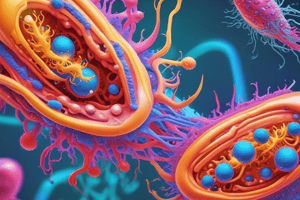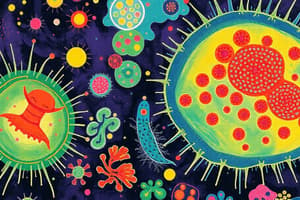Podcast
Questions and Answers
What type of reproduction involves the nuclear division followed by cytoplasmic division to produce merozoites?
What type of reproduction involves the nuclear division followed by cytoplasmic division to produce merozoites?
- Asexual binary fission
- Gamogony
- Schizogony (correct)
- Sexual sporogony
Which of the following stages is commonly associated with pathogenesis in parasitic protozoa?
Which of the following stages is commonly associated with pathogenesis in parasitic protozoa?
- Cyst
- Trophozoite (correct)
- Gamete
- Merozoite
In which life cycle stage does a protozoan typically form cysts that may contain multiple infective forms?
In which life cycle stage does a protozoan typically form cysts that may contain multiple infective forms?
- Maturation
- Sporozoite (correct)
- Trophozoite
- Excystation
What describes a life cycle that requires only one host species to complete?
What describes a life cycle that requires only one host species to complete?
What occurs during the process of excystation in protozoa?
What occurs during the process of excystation in protozoa?
Flashcards are hidden until you start studying
Study Notes
Protozoan Reproduction and Life Cycle
- Division methods vary: flagellates undergo longitudinal division, ciliates transverse division, while amebas lack a clear anterior-posterior axis.
- Schizogony involves multiple nuclear divisions followed by cytoplasmic division into uninucleate merozoites.
- In apicomplexans like Plasmodium and Toxoplasma, the sexual cycle comprises gamogony (gamete formation), zygote fertilization, zygote encystation to form oocysts, and sporogony (infective sporozoite production).
Life Cycle Complexity
- Protozoan life cycles can be simple (single host) or complex (two hosts).
- A single infective protozoan can lead to substantial population increases but is limited by host death or immune response, resulting in chronic infections.
- Trophozoite represents the active feeding and multiplying stage, often linked with pathogenicity in parasitic species.
Asexual and Sexual Stages
- Hemoflagellates express various trophozoite forms: amastigote, promastigote, epimastigote, and trypomastigote based on flagellum presence and kinetoplast position.
- Cysts may undergo multiplications where excystation can yield multiple organisms. For example, Entamoeba histolytica can form four metacystic amebas from a cyst with a single nucleus.
Vector-Borne and Predator-Prey Transmission
- Vector-borne transmission involves organisms like Trypanosoma brucei and Plasmodium spp., transmitted through blood-sucking arthropods.
- Predator-prey transmission exemplified by Toxoplasma gondii, where tissue cysts of the parasite are ingested by carnivores from herbivores.
Taxonomy of Protozoa
- Protozoa classified into several phyla: Sarcodina, Mastigophora, Sporozoa (Apicomplexa), Microsporidia, Cnidosporidia, and Ciliophora.
- Phylum Sarcodina includes organisms like Amoeba and Foraminifera, characterized by their amorphous shape.
Malaria and Health Impact
- In 2016, malaria affected 216 million individuals, causing 445,000 deaths globally.
- Plasmodium species can reside in the liver causing relapses; specific species exhibit long prepatent periods before symptoms appear.
Diseases and Hosts
- Leucocytozoon causes infections primarily in birds, transmitted by insects.
- Equine Piroplasmosis results from Babesia species, transmitted mainly through tick bites but can also spread via contaminated needles.
Myxosporidia Characteristics
- Myxosporidia are complex parasites forming spores with multiple cells and polar capsules. They primarily infect fish, leading to severe health impacts.
- Myxobolus species can cause significant disease in freshwater fish and affect their nervous system or lead to whirling disease in juvenile salmonids.
Microsporidia Overview
- Microsporidia are unicellular, obligate parasites affecting various hosts, including vertebrates and invertebrates.
- Nosema species are significant in agriculture, notably affecting honey bees causing nosemosis, and Nosema bombycis affects silkworms, leading to pébrine.
Common Protozoan Infections in Fish
- Chilodonella cyprini affects fish through asexual reproduction leading to visible skin and gill deterioration.
- Ichthyophthirius multifiliis causes "white spot disease," affecting various fish species and leading to rapid, contagious outbreaks.
Studying That Suits You
Use AI to generate personalized quizzes and flashcards to suit your learning preferences.




